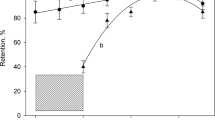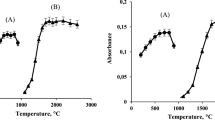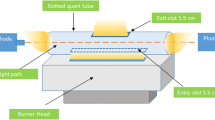Abstract
A procedure is proposed for the direct determination of lead in sea water by electrothermal atomization high-resolution atomic absorption spectrometry. The effect of background interferences due to sea water matrix is eliminated using a mixed modifier barium nitrate–hydrofluoric acid. The optimum amount of the modifier matrix is 60 µg Ba (NO3)2 + 1.52 µg HF. The conditions of analysis are as follows: pyrolysis temperature 600°C, atomization temperature 1200°C. The limit of detection for the developed procedure is 0.0003 mg/L.
Similar content being viewed by others
Explore related subjects
Discover the latest articles, news and stories from top researchers in related subjects.Avoid common mistakes on your manuscript.
It is known that lead is an ecotoxicant negatively affecting various biological processes [1]. The determination of its concentration in environmental samples belongs to high-priority tasks. The concentration of lead in uncontaminated natural waters of the World Ocean is, on the average, 0.01–0.02 µg/L [2]; however the maximum permissible concentration of lead in sea reservoirs for fishery use in the Russian Federation is established at 0.01 mg/L [3].
Sea is a complex sample for direct analysis because of the rather high concentration of salts dissolved in it. The main part of the inorganic matrix of the sea water is presented by salts of alkali and alkaline-earth metals [4]. It was shown [5] that the salt matrix negatively affects the reproducibility and accuracy of the results of metal determination in sea water. This is due to considerable chemical and spectral interferences, also caused by the joint atomization of the matrix and an analyte.
The majority of present-day procedures for the determination of heavy metals in sea water are based on the use of electrothermal atomization atomic absorption spectrometry. The stage of sample preparation, often necessary is this case, consists in the extraction of metals with organic complexants [6–10]. This stage is rather laborious and takes a lot of time. The need in sample preparation is due to the fact that inorganic salts forming the sea water matrix are high-boiling and cannot be removed at the pyrolysis stage. The atomization temperatures of the majority of these salts are comparable with the atomization temperature of lead [11]. This results in the formation of molecular vapor at the atomization stage, which is a source of background interferences.
A version of the direct determination of lead in sea water without sample preparation is known. In this case, the main components of sea water interfering with the determination of lead are sodium chloride and sulfate [5, 12–15]. To reduce the effect of the matrix, chemical modifiers were introduced into the atomizer together with the sea water, and this approach has received wide acceptance. The modifiers are used for the temperature stabilization of elements with rather low atomization temperatures and for the prevention of their preliminary atomization at the pyrolysis stage (magnesium nitrate; precious metal salts, i.e., palladium, platinum, and iridium nitrates) [12–18]. Modifiers capable of entering chemical reactions with the matrix, i.e., ammonium nitrate and oxalate or oxalic acid, are also used. They form easily volatile components on interaction with the matrix and are removed at the pyrolysis stage [19]. For example, the sublimation temperature of NH4Cl is 210°C; the decomposition temperatures of ammonium and sodium nitrates lie in the range from 380 to 600°C [20]. In [5], hydrofluoric acid was used as a chemical modifier for the reduction of the background signal of chlorides. This modifier reacts with chlorides with the formation of volatile hydrochloric acid, which is removed at the drying stage. The obtained sodium fluoride is atomized at 1700°C [20], i.e., at the temperature of higher than the atomization temperature of lead, and does not affect its determination. The selection of new modifiers for the determination of lead in sea water without sample preparation, aimed at increasing the reliability and reproducibility of the results of analysis, is an urgent task.
The goal of this work was the selection of modifiers for reducing the effect of the salt matrix and developing a procedure for the determination of lead in sea water by atomic absorption spectroscopy.
EXPERIMENTAL
The test samples were samples of sea water selected at the depth 200 m in the Greenland Sea. The samples were selected in plastic containers and preserved with nitric acid to pH 1–2. The salinity of water was 33 g/L.
Equipment. We used a ContrAA 700 high-resolution atomic absorption spectrophotometer (Analytic Jena, Germany) with pixel background correction, a continuous spectrum radiation source (high-pressure arc xenon lamp), and a transversely heated graphite furnace with a platform. Lead was determined at the wavelength 283.3060 nm. The measured signal was evaluated by the area of peak recorded at three pixels: the main (283.3060 nm) and two side ones (±12 pm). An inert gas, high-purity (99.998%) argon, was used as a shielding gas. The test solution was placed in a graphite cell using an AS-52s autobatcher. The volume of the sample was 10 µL. The temperature program of the determination of lead is presented in Table 1.
Reagents and materials. We used a Merck multielement standard in 0.1 M HNO3 to construct a calibration dependence. The modifier was hydrofluoric acid of chemically pure grade (45%) (Sigmatek), palladium and magnesium nitrates (98%) (Merck), and chemically pure barium nitrate (Neva Reaktiv).
Preparation of solutions. A model solution of sea water [4] was prepared using reagents of chemically pure and better grade. Weighed portions taken on analytical balances, 23.476 g of sodium chloride, 4.981 g of magnesium chloride, 3.917 g of sodium sulfate, 1.102 g calcium chloride, and 0.664 g of potassium chloride, were put in an 1 L volumetric flask and made up with deionized water. Individual salt solutions were prepared similarly, by adding a salt weighed portion to a 1 L flask.
The modifiers were prepared as follows: a 0.5-g weighed portion of barium nitrate weighed on analytical balances was placed in a volumetric flask and made up to 1L with deionized water. The HF modifier (45%) was added directly to the graphite furnace.
RESULTS AND DISCUSSION
Identification of background interferences. It is known [16–19] that chlorides and sulfates significantly affect the reproducibility of the results of analysis, especially at low limits of detection. The study performed showed that matrix components significantly affected the results of lead determination. The signal observed at the wavelength 273.8 nm overlapped with the signals of interferences due to the salt matrix (Fig. 1).
To exclude possible effects of various components of sea water, other than sulfates and chlorides, on the determination of lead, we recorded spectra of model sea water. A comparison of the spectra of real and model sea water showed their identity (Fig. 1).
We recorded spectra of individual salt solutions under identical conditions. It can be seen in Fig. 2a that the spectra of magnesium, calcium, and potassium chlorides are free from strong fluctuation interferences, characteristic for the spectra of sea water. The spectrum of sodium sulfate (Fig. 2b) was almost identical to the spectrum of sea water. Sulfate ions strongly affected the results of lead determination because of spectral superpositions.
Therefore, it was found that the interfering effect of sea water matrix was due to only the presence of sulfates and chlorides in it. The further studies were aimed at the elimination of these effects.
Selection of modifiers for the direct determination of lead. The interfering matrix must be eliminated for the direct determination of lead in sea water. To remove sulfates, we chose a barium nitrate solution with the concentration 5 g/L as a chemical modifier; it was added in excess to ensure the complete interaction of the sulfate ions of sea water with the formation of barium sulfate, for which atomization temperature is higher than the atomization temperature of lead [11].
The determination of the concentration of lead ions in sea water with additions of lead ions (total concentration of lead 0.05 mg/L) and the use of a barium nitrate modifier (Fig. 3a) allowed us to significantly reduce spectral interferences. However, the spectrum in this case exhibited a rather intense background signal due to the presence of chloride ions, the peak of which superimposed with the analyte peak (Fig. 3b). To exclude the simultaneous effect of sulfates and chlorides in the direct determination of lead concentration in sea water, we proposed to add a mixed modifier barium nitrate–hydrofluoric acid to the test sample. Barium nitrate prevents the simultaneous atomization of sulfates and lead, and hydrofluoric acid removes chlorides from the sample at the pyrolysis stage. The spectrum exhibits no fluctuations, and the background signal is insignificant and does not overlap with the maximum of the analytical signal (Fig. 4).
The next step of investigation was the selection of optimum temperatures for atomization and pyrolysis, and also the weight ratio of the chosen modifiers – barium nitrate and hydrofluoric acid – for the achievement of the best sensitivity at the minimum effect of the matrix on the results of analysis and a decrease in the effect of aggressive media on the graphite furnace. It was found (Table 2) that the minimum volumes of modifier solutions completely eliminating the effect of the matrix on the determination of lead in sea water were 12 µL of a solution of barium nitrate with the concentration 5 g/L and 3 µL of 45% hydrofluoric acid added to 10 µL of a sea water sample. Therefore, the optimum weights of modifiers were 60 µg of Ba(NO3)2 and 1.52 µg of HF.
To determine the optimum atomization temperature, we compared absorbance signals of standard lead solutions with the concentration 0.05 mg/L in 0.1 M nitric acid and in sea water on varying this parameter. It can be seen in Fig. 5 that the optimum atomization temperature is 1200°C. Similarly we selected the optimum temperature of pyrolysis (Fig. 6), which was 600°C. Under the chosen conditions, we observed the minimum distinctions in the analytical signals of the standard solution and the solution of lead in sea water.
Tests of procedure for the determination of lead. Analyses of real sea water samples were performed under the chosen conditions. The concentration of lead was calculated by a calibration dependence (coefficient of correlation 0.9996); characteristic concentration and the limit of detection for lead were determined.
To confirm the reliability of the determination of lead in sea water under the selected conditions, we used the added–found method. Lead was determined using a mixed modifier composed of 12 µL of a Ba(NO3)2 solution (5 g/L) + 3 µL of 45% HF under the chosen temperature conditions.
It was shown that the proposed approach ensures the elimination of the matrix effect of sea water in the determination of lead without preliminary sample preparation. On the introduction of lead ions in the concentration 0.050 mg/L into the sea water, 0.047 mg/L of lead was found. The error of determination by the spike recovery test was 6.0% and the standard deviation was 0.0041 mg/L.
By the previous results of ten replicate determinations of lead ions in sea water under the conditions chosen (temperature of pyrolysis and atomization, ratio of modifiers), the characteristic concentration of lead was 0.00035 mg/L and the limit of detection for lead was 0.0003 mg/L, which is about 30 times lower than the maximum permissible concentration for fishery reservoirs. Relative error at P = 0.95 was 2.9% at the analyte concentration 0.005 mg/L [21, 22].
REFERENCES
Juberg, D.R., Lead and Human Health: An Update, New York: Am. Council Sci. Health, 2000.
Chester, R., Marine Geochemistry, London: Unwin Hyman, 1990.
Perechen’ rybokhozyaistvennykh normativov: predel’no-dopustimykh kontsentratsii i orientirovochno bezopasnykh urovnei veshchestv dlya vody, vodnykh ob”ektov, imeyushchikh rybokhozyaistvennoe znachenie (List of Fisheries Standards: Maximum Permissible Concentrations and Approximately Safe Levels of Substances for Water, Water Bodies of Fishery Importance), Moscow: Vseross. Nauchn.-Issled. Inst. Ryb. Khoz. Okeanogr., 1999.
Horne, R.A., Marine Chemistry: Structure of Water and the Chemistry of the Hydrosphere, New York: Wiley, 1969.
Cabon, J.Y., Spectrochim. Acta, Part B, 2002, vol. 57, p. 513.
Creed, J.T. and Martin, T.D., Determination of Trace Elements in Marine Waters by Off-Line Chelation Preconcentration with Graphite Furnace Atomic Absorption, Method 200.13, Cincinnati: United States Environmental Protection Agency, 1992.
Wells, M.L. and Bruland, K.W., Mar. Chem., 1998, vol. 63, p. 145.
Kojuncu, Y., Bundalevska, J.M., Ay, U., Čundeva, K., Stafilov, T., and Akçin, G., Sep. Sci. Technol., 2004, vol. 39, p. 2751.
Gladis, J.M., Biju, V.M., and Prasada Rao, T., At. Spectrosc., 2002, vol. 23, p. 143.
Shiowatana, J., Benyatianb, K., and Siripinyanond, A., At. Spectrosc., 2000, vol. 21, p. 179.
Khavezov, I. and Tsalev, D., Atomno-Absorbtsionen Analiz (Atomic-Absorption Analysis), Sofia: Nauka Izkustvo, 1980.
Cabon, J.Y. and Le Bihan, A., Spectrochim. Acta, Part B, 1996, vol. 51, p. 1245.
Ortner, H.M., Bulska, E., Rohr, U., Schlemmer, G., Weinbruch, S., and Welz, B., Spectrochim. Acta, Part B, 2002, vol. 57, p. 1835.
Alemasova, A.S., Vysokotemperaturnye protsessy prevrashcheniya kompleksoobrazovatelei i kompleksov metallov v atomno-absorbtsionnom analize (High-Temperature Transformation Pprocesses of Complexing Agents and Metal Complexes in Atomic Absorption Analysis), Donetsk: Donetsk. Gos. Univ., 1997.
Tsalev, D.L., Slaveikova, V.I., and Mandjukov, P.B., Spectrochim. Acta Rev., 1990, vol. 13, no. 3, p. 225.
Bin, H. and Zhe-Min, N., J. Anal. At. Spectrosc., 1996, vol. 11, p. 165.
Volynsky, A.B., Akmana, S., Dogana, C.E., and Koklua, U., Spectrochim. Acta, Part B, 2001, vol. 56, p. 2361.
Acar, O., Talanta, 2005, vol. 65, p. 672.
Pupyshev, A.A., Atomno-absorbtsionnyi spektral’nyi analiz (Atomic Absorption Spectral Analysis), Moscow: Tekhnosfera, 2009.
Dean, J.A., Lange’s Handbook of Chemistry, New York: McGraw-Hill, 1999, 15th ed.
Smagunova, A.N., Metody matematicheskoi statistiki v analiticheskoi khimii (Methods of Mathematical Statistics in Analytical Chemistry), Rostov-on-Don: Feniks, 2012.
Sachs, L., Statistische Auswertungsmethoden (Statistical Evaluation Methods), Berlin: Springer, 1968.
ACKNOWLEDGMENTS
This work was performed using instrumentation of the “Arktika” Core Facility Center of the Northern (Arctic) Federal University (project RFMEFI59417X0013).
Author information
Authors and Affiliations
Corresponding author
Additional information
Translated by E. Rykova
Rights and permissions
About this article
Cite this article
Sobolev, N.A., Ivanchenko, N.L. & Kozhevnikov, A.Y. Direct Determination of Lead in Sea Water by High-Resolution Atomic Absorption Spectroscopy Using a Mixed Modifier Barium Nitrate–Hydrofluoric Acid. J Anal Chem 74, 444–448 (2019). https://doi.org/10.1134/S1061934819020126
Received:
Revised:
Accepted:
Published:
Issue Date:
DOI: https://doi.org/10.1134/S1061934819020126










